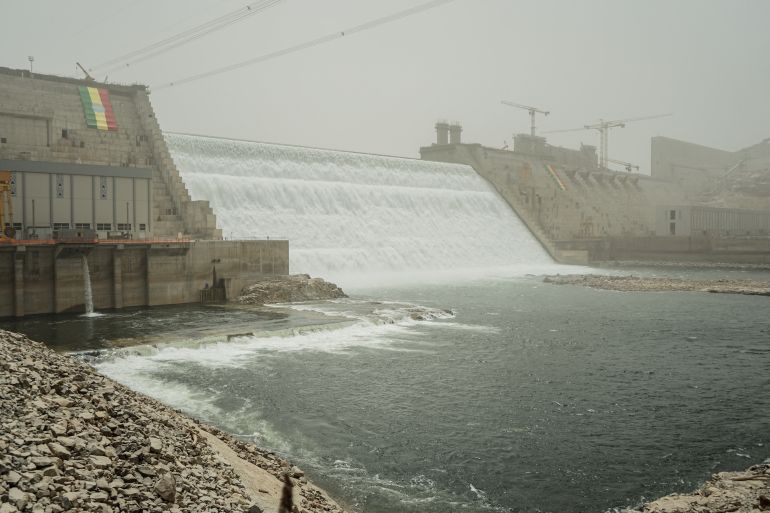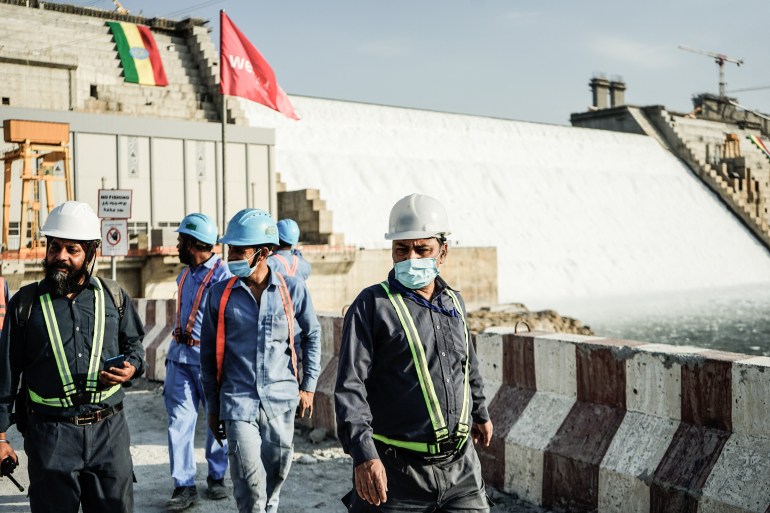Ethiopia’s Blue Nile mega-dam explained
Grand Ethiopian Renaissance Dam is the source of an almost decade-long diplomatic standoff between Ethiopia, Egypt and Sudan.

Ethiopia has started generating electricity from the controversial mega-dam that is being built on the Blue Nile.
The milestone was reached on Sunday morning when one of the 13 turbines of the Grand Ethiopian Renaissance Dam (GERD) started power generation in an event officiated by Prime Minister Abiy Ahmed.
Keep reading
list of 4 itemsEthiopia resumes filling mega-dam, infuriating Egypt
Ethiopia’s Renaissance Dam: Has diplomacy failed?
Sudan wants UN Security Council to discuss Ethiopia’s Nile dam
The dam has been a source of tension between Ethiopia and the other riparian states, Sudan and Egypt.
Ethiopia has already conducted two fillings of the dam, but the speed at which it will be filled and the amount of water that will be released during drought seasons remains unsolved.
Egypt fears a quick filling of the dam will reduce its share of Nile waters and seeks a binding legal agreement in case of a dispute. Sudan hopes the project will regulate annual flooding but fears its own dams could be harmed without agreement on the GERD’s operation.
Addis Ababa contends the dam is essential for its development and will enable it to distribute power to its population of more than 110 million.
Several rounds of talks have been held in attempts to solve the stalemate.

Here are a few things to know about the giant hydropower dam:
What is the project about?
The Grand Ethiopian Renaissance Dam (GERD) is the source of an almost decade-long diplomatic standoff between Ethiopia and downstream nations Egypt and Sudan.
The $4.2bn (€3.7bn) GERD was announced in early 2011 as Egypt was in political upheaval.
It is the centrepiece of Ethiopia’s bid to become Africa’s biggest power exporter, with a projected capacity of 6,500 megawatts.
Construction of the 145-metre (475-foot) high structure has been hit by delays due to mismanagement, according to officials.
The reservoir’s total capacity is 74 billion cubic metres. The process of filling the vast reservoir began in 2020, with Ethiopia announcing in July of that year it had hit its target of 4.9 billion cubic metres. Last July, Ethiopia said it had hit that target, adding 13.5 billion cubic metres.
Once it is finalised it will become Africa’s largest hydroelectric power generator and the world’s seventh-largest dam, according to reports in Ethiopia’s state media.

Nile water
The Nile Basin river system flows through 11 countries. The Blue Nile and White Nile merge in Sudan before flowing into Egypt and on to the Mediterranean Sea.
Egypt has based its share of the river’s waters on a 1959 deal that gave it 55.5 billion cubic metres of water annually, and Sudan 18.5 billion cubic metres.
Other countries were not given allocations at that time and Ethiopia does not recognise the agreement.
The dispute centres on how quickly Ethiopia should fill and replenish the reservoir, and how much water it would release downstream in case of a multi-year drought.
What does Egypt say?
Egypt, which has a rapidly growing population of more than 100 million, relies on the Nile for at least 90 percent of its freshwater.
The largely desert country is already short of water. It imports about half its food products and recycles about 25 billion cubic metres of water annually.
Egypt is most worried about the risk of drought conditions such as those that occurred in the late 1970s and early ’80s, and has pushed for Ethiopia to fill the reservoir over a longer period if needed and guarantee minimum flows.
If water flows are restricted in drought conditions Egypt says it could lose more than one million jobs and $1.8bn in economic production annually, though it acknowledges such a scenario is unlikely.
Overall, Egypt has regarded the dam as an existential threat to its water supplies.
Cairo denounced Sunday’s start-up, saying Addis Ababa was “persisting in its violations” of a 2015 declaration of principles on the project.
What does Ethiopia say?
Ethiopia, with a population of more than 110 million, accuses Egypt of trying to maintain a colonial-era grip over the Nile’s waters by imposing rules over the dam’s filling and operation.
It has said it is taking the interests of Egypt and Sudan into account, and that Egypt’s requirements of guaranteed flows are unrealistic.
It has also said it could finish filling the reservoir in two to three years, but made a concession by proposing a four-to-seven year process.
Ethiopia also says the power produced by the huge hydroelectric project is indispensable for its development.
What is Sudan’s position?
Sudan does not face shortages in its Nile water supplies and it could gain from the dam’s electricity generation, as well as flood mitigation.
However, Sudan is concerned about the safety of the dam, which lies just on the other side of its border with Ethiopia.
Khartoum has called for information sharing in order to minimise the effect on its own dams and water stations, and took precautionary measures at its own dams before the GERD’s second filling, citing a lack of data from Ethiopia.

Talks
Both sides have blamed each other for negotiations repeatedly stalling. Talks hosted by Washington broke down last year, and an effort to relaunch them in Kinshasa earlier this year also failed.
While the African Union has facilitated recent efforts, Sudan and Egypt have called for the United States, the European Union, and the United Nations to mediate directly.
Ethiopia has resisted this, saying that diplomacy outside the AU process was “demeaning” to the African body’s efforts.